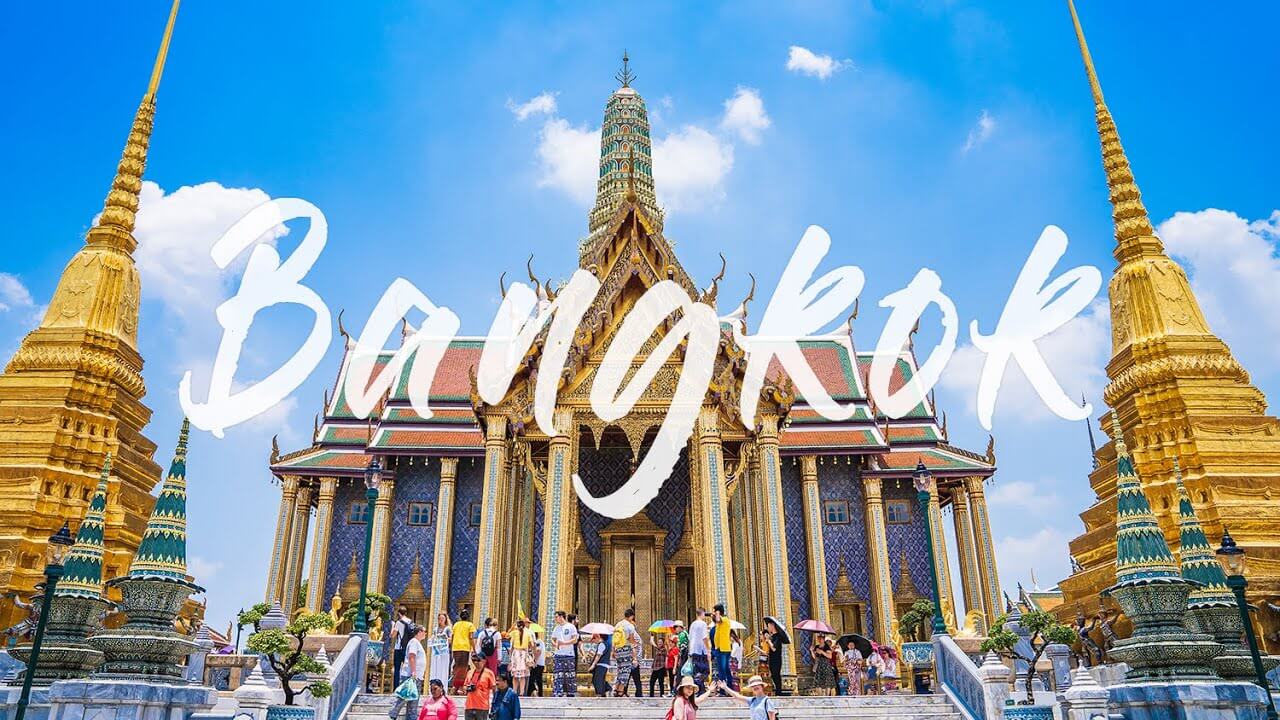Known as the City of Angels, Bangkok, the capital of Thailand is filled with hundreds of amazing temples and shrines. It has been a central point for visitors from around the world to experience some of the best of what Southeast Asia has to offer.
In Bangkok merchants trade imaginable good under the sun, with an upbeat street life and amazing street food visitors can haggle for reasonable prices from the street vendors or at the floating kitchens on river boats on one of Bangkok’s colorful floating markets.
Visit Bangkok to experience the ultimate hustle and bustle of one Southeast Asia’s most visited capitals, enjoy the culture, architecture, and food! Thailand is a country full of beautiful landscapes, amazing beaches and delicious cuisine.
We have included the best things to do in Bangkok in 3 days to enjoy the highlights of this city. This Bangkok 3 day itinerary has you covered!
➳ Find all: Hotels in Bangkok
- Important things you should know before visiting Bangkok:
- When is the best time to visit Bangkok?
- How long should I stay in Bangkok?
- Important items to pack when visiting Bangkok
- How to get to Bangkok?
- How to get from the airport to the Bangkok city center?
- Where to stay in Bangkok?
- What is the best way to get around Bangkok?
- By Boat
- By bus
- How much money do I need for 3 days in Bangkok?
- What is the currency in Thailand?
- How to get a sim card in Bangkok?
- Walking map of the best things to do in Bangkok
- What to do in Bangkok in 3 days itinerary
- DAY 1: Visit Bangkok’s main temples
- 1. Wat Arun
- 2. Wat Pho
- 3. Grand Palace and Wat Phra Kaew
- 4. Chao Phraya River Boat
- DAY 2: Visit more temples and rooftops
- 5. Wat Saket
- 6. Wat Ratchanatdaram and Loha Prasat
- 7. Wat Benchamabophit
- 8. Baiyoke Sky Tower Observation Deck
- DAY 3: Visit more temples and let’s go shopping!
- 9. Chatuchak Weekend JJ Market
- 10. Wat Yannawa
- 11. Wat Traimit Withayaram Worawihan
- 12. Khao San Road and Soi Rambuttri
- Thai Massage
- If you have extra time:
- Damnoen Saduak and Bangkok Floating Markets
- Wat Samphran (Dragon Temple)
- Ancient Siam
- Wat Makutkasattriyaram
- Wat Intharawihan
- Democracy Monument
- Giant Swing at Wat Suthat
- National Museum
- Dusit Palace Park
- Vimanmek Mansion
- National Assembly of Thailand
- Government House
- Victory Monument
- Erawan Shrine (Small Buddha)
- Lumpini Park
- Sri Maha Mariamman Temple
- Chinatown Gate
- Dusit Zoo
- Save this article for later ⇟
Important things you should know before visiting Bangkok:
- You are required to cover your shoulders and knees to enter all the temples, for both males and females. It is best to wear a long dress or long skirt. We recommend buying a sarong from any of the stores near the temples or at the market. It cost about $5USD and they are comfortable, lightweight and protects you from the strong sun. Plus, they look amazing!
- Some countries such as Ecuador require a visa and a yellow fever vaccination card to visit Thailand.
- Watch out for tuk tuks tour guides as some will stand outside popular tourist attractions saying it is closed and offer their tour services for “better spot” instead. This often includes making at least one stop at a tailor or jewelry shop that the driver gets commission from, while missing out on the attraction you actually wanted to visit in the first place. If you have some extra time in Bangkok it can be a fun way to just explore the city by tuk tuk at a reduced price. We did it that way and it was so much fun as we became friends with the driver.
- Make sure street vendors provide proper change. Do not feel rushed to make a purchase or accept the change if you are not familiar with the bills to make sure you got the right amount of change. Try using small bills or pay the exact price.
- Do not accept “free gifts” from vendors on the street as they will ask for money after you accept it and will not take the gift back.
- Be ready to negotiate as you can reduce prices 20% to 40%. It is easier when buying multiple items from a shop. Bargaining is a cultural occurrence, and it is best to have the vendor give the price first before negotiating.
When is the best time to visit Bangkok?
The best time of year to visit Bangkok and the rest of Thailand is from mid-November to mid-April. However, keep in mind that no matter when you visit, it will be hot! Do not expect temperatures lower than 20°C (68 °F). That is why it is crucial to bring sunscreen, a hat and drink PLENTY of water!
Thailand has two seasons: dry season and monsoon season. During the monsoon season, which starts early June to mid-October, you can expect rain. It is not as bad as it sounds, as it might rain for a couple of hours throughout the day. During the dry season, which goes from December to late February, you can expect lower temperatures (though still relatively warm).
If you want to avoid crowds, take advantage of cheaper accommodations and better weather then we recommend visiting Bangkok either in late March, April or November.
How long should I stay in Bangkok?
There are so many things to do in Bangkok, that is why we recommend spending a minimum of two to three days exploring the city. In two days you can see the main highlights but probably you would like to have an extra day to rest and enjoy at a more relax pace. You could ultimately spend a week to a month more in Bangkok exploring each neighborhood, but we found this itinerary to be sufficient to see the highlights. The sun is strong and takes its toll durning the day and you will be exhausted by the end of the day. In this ultimate 3-day itinerary you will see why we recommend at least 3 days!
Important items to pack when visiting Bangkok
Here is a list of essentials you must need to pack for your trip to Bangkok and Thailand in general.
- Filtered Water Bottle
- Sunscreen
- Long, lightweight clothes for visiting temples
- Power adapter
- Sunglasses
- Hat or a cap
- Small backpack
- Camera
- Comfortable walking shoes and sandels
- Travel Insurance
How to get to Bangkok?
In this guide we will share the best things to do in Bangkok in 3 days. We will make sure you have the best experience and get to see the main highlights of Bangkok as well as its hidden gems. We will start with some important information you should know on how to actually get to this amazing city.
- By plane: There are two international airports: Suvarnabhumi airport and Don Mueang airport. When you are leaving Bangkok make sure you are heading to the right airport as they are almost an hour drive apart in traffic.
- By train: You will probably be arriving at the main railway station, Hua Lamphong Station, which is located in the Pathum Wan District. Trains from this station connect to cities like Chiang Mai, Chumphon, and Surat Thani. We recommend buying your tickets ahead of time during high season just to be safe. The prices of the tickets vary based on the length of the route and the fare class you choose.
- By bus: The bus system in Thailand is very well connected. There are many routes that connect Bangkok with all major Thai cities and even the southern islands. Some routes even offer a night bus option. You can purchase your ticket at the bus station or online.
How to get from the airport to the Bangkok city center?
There are two main international airports in the city: Suvarnabhumi and Don Mueang. Although, the main airport is Suvarnabhumi.
- If you are arriving from Suvarnabhumi airport (the largest airport) the best option is to take the BTS (skytrain) as it is an easy 30 minute ride and it cost between 15 to 45฿, while a taxis cost about 400฿. From the city you can take a taxi to your hotel and save some money. We took a rail link from the airport to the metro for 45฿ each. Then the cost of the metro depends on how many stops you are going, in our case it was an additional 31฿ each.
- If you come from Don Mueang the only option is to take a taxi to the city. Taxis cost about 400 ฿.
Where to stay in Bangkok?
- Luxury: 137 Pillars, Lebua, The Okura Prestige Bangkok, or Rosewood Bangkok
- Mid-range: Eastin Grand Hotel Sathorn, Avani Riverside, Hotel Muse Bangkok, Casa Nithra, Rembrandt Hotel, Suites Bangkok and Hotel Icon.
- Budget Friendly: Travelodge Sukhumvit 11, Shanghai Mansion, Prime Hotel Central Station Bangkok, Vera Nidhra Bed & Breakfast or 21 Sala Daeng.
If you are interested in staying in a Bangkok hotel with an infinity pool here are some options:
- Luxury: The Okura Prestige, Sindhorn Midtown Hotel Bangkok, InterContinental Bangkok, Avani Plus Riverside Bangkok Hotel, Bangkok Marriott Hotel Sukhumvit, Sivatel Bangkok, and Park Hyatt Bangkok.
- Mid-range: SO/ Bangkok, Akyra Thonglor Bangkok, Eastin Grand Hotel Sathorn, Ad Lib.
- Budget: Amara Bangkok Hotel, Hotel Solo, Novotel Bangkok Sukhumvit 20, Travelodge Sukhumvit 11, Jasmine Grande Residence, and Sivatel Bangkok.
What is the best way to get around Bangkok?
Bangkok have so many different transportation options for you to move around the city. You can either take the metro, Gojek motorbikes, the skytrain, taxis, tuk-tuks, and buses. The best way to save money is to use Google Maps and plan a route by sections of the city for the day to avoid zig-zagging across the city. Start by reading our 3 day Bangkok itinerary for reference.
Before getting into the travel guide part of this post, we wanted to talk about getting around the large city of Bangkok. While we always prefer walking, the consistent heat hovering above 90°F(32°C) and long distances demands the usage of motorized vehicles.
Taxi/Grab/Bolt
Keep in mind that with taxis and tuk tuks you need to always bargain as they will always try to charge more than it actually costs. We recommend downloading apps like “Grab” or “Bolt” to get a set price to your destination. We found these apps to be cheaper than what you can get when negotiate directly. Also keep in mind that Bolt is cash only, while Grab you can pay with your credit card.
In our experience the metered taxi is the cheaper way to go as a tourist but most taxis we encountered did not want to use the meter, even though it is technically required. Just be careful which taxi you get in, as each company has different rates. Other than that, a set rate taxi offers a better price than tuk tuks, as people ride them as a tourist attraction and locals get a drastically lower price. Even if you haggle down the prices, it is still tend to be higher than the meter taxi.
For example, we sat in a metered taxi during rush hour traffic for 45 minutes and it still only cost 75% of the drivers set rate offer!
Tuk Tuk
Taking in tuk tuk in Thailand is an experience in itself. Even though riding in a tuk tuk is more expensive than a taxi or an app it is still one of the best things to do in Bangkok. Tuk tuks can take you anywhere around the city, and try to avoid traffic by cutting around cars whenever possible. I recommend at least experience one Tuk Tuk ride during your stay in Bangkok.
Make sure you agree on the price before getting on the tuk tuk. Sometimes the tuk tuk driver will offer you a better price if you allow him to make some stops along the way. What he means with stops is taking you to expensive shops where they get commissions for bringing people into the store.
Our first time riding a tuk tuk, the driver ask us if we could make different stops, as we had extra time and we wanted to experience a tuk tuk at a cheaper price we agreed. We thought we were not going to buy anything, we did actually end up buying a tailored suit and shirts for Steven. They are great quality, still going strong 7 years later, and we were able to negotiate a price that was the same price as a similar quality but non-tailored suit in the US.
By Boat
Bangkok has several piers along the Chao Phraya river. It is better, cheaper and faster, to tke a boat ride to cross the river rather than having to walk or grab a taxi to the other side.
The Chao Phraya Express Boat has 5 lines that take you to different places around the city. The only one that runs 7 days a week is the Orange Line. The flat rate per ride is 15 THB (0.50 USD).
By BTS Skytrain
If you choose to use public transportation as your means of transportation then we recommend using the Skytrain. Depending on the distance the fees vary from 16 to 44 THB (0.50 to 1.50 USD). If you are planning using it a lot then it might be better to get a one-day pass, which costs 140 THB (4.50 USD). The Skytrain operates from 5:15 am to 12:50 am depending on the destination.
Another option is the MRT, which is the Bangkok metro. It has two lines: the Blue and Purple, that connect the city. Prices are similar to the Skytrain and it is open from 6:00 am to 12:00 am.
By bus
The bus system in Bangkok is very good and well connected. Rates vary from 7 THB for un-air conditioned buses (0.20 USD) to 24 THB (0.80 USD) for buses with air conditioning. You can only pay in cash on the bus and the price is calculated based on the distance you are traveling. Buses run from 5:00 am to 11:00 pm. There are several lines that run 24 hours.
How much money do I need for 3 days in Bangkok?
- Hotel: You can expect to spend about $40 to $150 USD a night in a nice hotel. Although you can find cheaper accommodations like hostels and Airbnbs (which can range from $15 to $60 USD a night). It all depends on your budget and preferences.
- Food: You should budget around $10 to $15 USD a day per person. Again, it depends on the kind of food and restaurants you want to eat but eating street food or at local stalls is only a few dollars a meal.
- Transportation: We spent around $20 USD a day in transportation. Although we did a combination of walking, bus and using the Grab taxi app. We tried not to use tuk tuks much because they tend to cost more than a regular taxi.
- Sim card: It depends on the amount of data you need but prices range from $9 to $45 USD.
- Entrance fees: Depending on the number temples you go to you can spend around $4 to $7 USD daily in just entrance fees.
➳ Read More: Things To Do in Phuket, Thailand in 2 Days
What is the currency in Thailand?
Thailand’s currency is called Baht (฿).
The exchange rate as of 2023 is about 34฿ to 1 USD. We recommend getting a debit card that reimburses any ATM fees, as that is the best way to get the market exchange rate. However, always travel with some cash in case the ATM card doesn’t work the first couple of days or you don’t have an ATM nearby.
How to get a sim card in Bangkok?
We recommend to get one at the airport to have internet to find your hotel and not have to worry about finding a shop after traveling. There are several shops with different plans and prices going from 399฿ to 1,599฿ for unlimited 5G max speed data.
Walking map of the best things to do in Bangkok
We have added all the places you must visit in Bangkok in three days in this map. You can follow the days in any order for the ultimate 3 day itinerary for Bangkok. The only thing to keep in mind is going to the most popular attractions first thing in the morning to avoid crowds.
You can save this map on your phone. You just need to open up this 3 day in Bangkok itinerary on your phone and then click on the bracket in the upper right corner of the map, it will automatically open up in the Google Maps app, where you can save it. I recommend downloading the Bangkok map on your phone in case your internet is running slow or there is not service.
What to do in Bangkok in 3 days itinerary
If you are in Bangkok you need to visit the Grand Palace, Wat Pho, Wat Arun, Wat Phra Kaew, the Floating Market and the Chatuchak Market. We have included our favorite spots in Bangkok for you to visit in three days.
➳ Did you know that the word Wat means “Temple” in Thai?
As you are going to be visiting temples on the first and second day please make sure to wear appropriate clothing. You need to cover both your knees and shoulders. Do not wear tight clothes either. Make sure to bring a hat (it gets very hot especially in the afternoon) and a pair of socks even if you are wearing sandals as you will have to remove your shoes to enter each temple!
Without further ado, let’s start off with our Bangkok itinerary by wishing you an amazing time in the city!
DAY 1: Visit Bangkok’s main temples
Day one has the best of our Bangkok itinerary, so if you do not have three days to spend in Bangkok, the first day of this three days itinerary is a good reference. The first day is packed with the main highlights of Bangkok. So if you only have one day in Bangkok, then focus on day 1 to plan your own itinerary. We have added the most famous Bangkok’s temples and most popular sights first in order to get them out of the way sooner and then focus on the rest sights Bangkok has to offer. (I want to say something about in case it rains or there is bad weather at least you got to see the most important sight!)
1. Wat Arun
One of the best things to do in Bangkok is visiting Wat Arun, the temple of dawn. It is considered to be one of the most beautiful temples in Thailand and even Southeast Asia. Dominating the riverside of the west (Thonburi) bank of the Chao Phraya River, Wet Arun is a Buddhist temple that got its name after a Hindu god Aruna, the god of dawn who is often portrayed in a form of rays of the rising sun. Just like the name suggests, the most stunning time of the day to observe the temple is the early morning with the first rays of sun opulently shimmering over the temple’s surface.
The most prominent architectural feature of the temple is 82m-high þrahng (Khmer-style tower) embellished by pieces of porcelain once discarded as ballast by Chinese ships calling at the port of Bangkok. There are five white temples total that are covered in beautiful and colorful ceramic tiles.
The temple is open daily 8:00 am to 5:30 pm. Tickets cost 100฿ per person and you can buy it at the booth at the temple. Expect to spend at least 1 to 2 hours.
➳ Tip: Climb to the top for a panoramic view of the river and the city.
You can take a ferry from the ferry point to the other side of the river to visit the Grand Palace and Wat Pho. The ride takes about 5 minutes and it cost 5฿ per person.
Did you know that the full name of the temple is Wat Arun Ratchawararam Ratchawaramahawihan?
2. Wat Pho
Wat Pho is Bangkok’s most popular and oldest temple because of its beauty and its 46 meter long and 15 meter high covered in gold leaf and with mother-of-pearl ornaments inlaid on his feet reclining Buddha. It represents Buddha entering nirvana (Buddha’s death).
In fact, it houses the largest Buddha in Thailand. You can spend hours taking photos around the temple, every corner is full of color. It is a truly piece of art. Good luck trying to get a good photo of the reclining Buddha, it is so big that you must get creative to find a good angle!
You will also find a statue’s hall, with 108 bronze bowls representing the auspicious characters of Buddha. You can buy packs of 108 coins at the entrance drop one coin into each bowl for good luck.
The temple has a total of 91 stupas with each having the ashes of previous Thai kings.
The entrance fee is 100฿ ($3 USD) per person and it is open from 8:00 am to 6:30 pm. The walk from Wat Pho to the Grand Palace to is about 10 to 15 minutes. They are pretty much next to each other. Expect to spend at least 2 hours. Make sure to add Wat Pho to your 3 days in Bangkok itinerary!
Did you know that Wat Pho is the birthplace of southern style Thai massage? It has one of the best massage schools in Thailand. We recommend booking your session before exploring Wat Pho to avoid having to wait in line and taking advantage of your time in Bangkok. A 30 minute session costs 320 baht (10 USD) and an hour massage cost 540 baht (17 USD). We have found cheaper massage options but this is a good price too!
3. Grand Palace and Wat Phra Kaew

The Grand Palace is one of the highlights of the old city in Bangkok, built in 1782. It used to be the home to the Thai king for more than 150 years. It is one of the most beautiful places in Bangkok with beautiful temples and many Buddhist statues. It commands awe attention to the intricate and delicate work of generations of Thai craftsmen who created this amazing complex worthy of kings and other dignitaries.
Inside of the complex it is also the Wat Phra Kaew, Temple of the Emerald Buddha, where you can see the Emerald and gold Buddha clothed in pure gold. The Emerald Buddha represents legitimacy and prosperity, and it is also the most important representation of Buddha and the most important Buddhist temple in the country. It can be wearing any of the 3 different costumes (summer, winter, or rainy season), which is change 3 times a year in a ceremony held at the temple by his majesty, the king.
Without a doubt, visiting the Grand Palace and the Emerald Buddha is a must see in your three days in Bangkok.
In a country that boasts with more than 40,000 temples, the Wat Prakeaw is high on the list of the most important ones. The statue of the Emerald Buddha is housed in the main building of the temple known as Ubosoth.
The Grand Palace is open daily 8:30AM to 3:30PM. Tickets cost 500฿ ($15 USD) per person and it also gives you access to visit the Queen Sirikit Museum of Textiles, Wat Phra Kaew and a show at the theatre. The tickets can be purchased at the palace or online.
Expect to spend between two to four hours at the Grand Palace. It all depends how quickly you want to go through and how many photos you want to take.
4. Chao Phraya River Boat
We recommend to take a boat tour along the Chao Phraya river with Chao Phraya Tourist Boat. You can hop-on and hop-off at their 9 different stops along the way. Tickets cost 350 THB (12 USD) and you can purchase it online or at the pier. Boats run between 9 am to 8.30 pm everyday.
If not you can just take an hour boat ride that takes you along the floating markets and various attractions from most ferry stations, including Wat Arun. You can buy this one-hour tour on a longboat for about THB 1200-1300 for two people.
Historically traffic in Bangkok heavily relied on hundreds of small river canals. “Bangkok is known as the Venice of the East”. Today, most of these canals have turned into streets, although the area of old capital Thonburi covering an area of west of the Chao Phraya river has retained much of the old canals. You can book river boat tour to get a glimpse into Thai traditional way of life while passing lush fields, orchards, and family farms.
DAY 2: Visit more temples and rooftops
5. Wat Saket
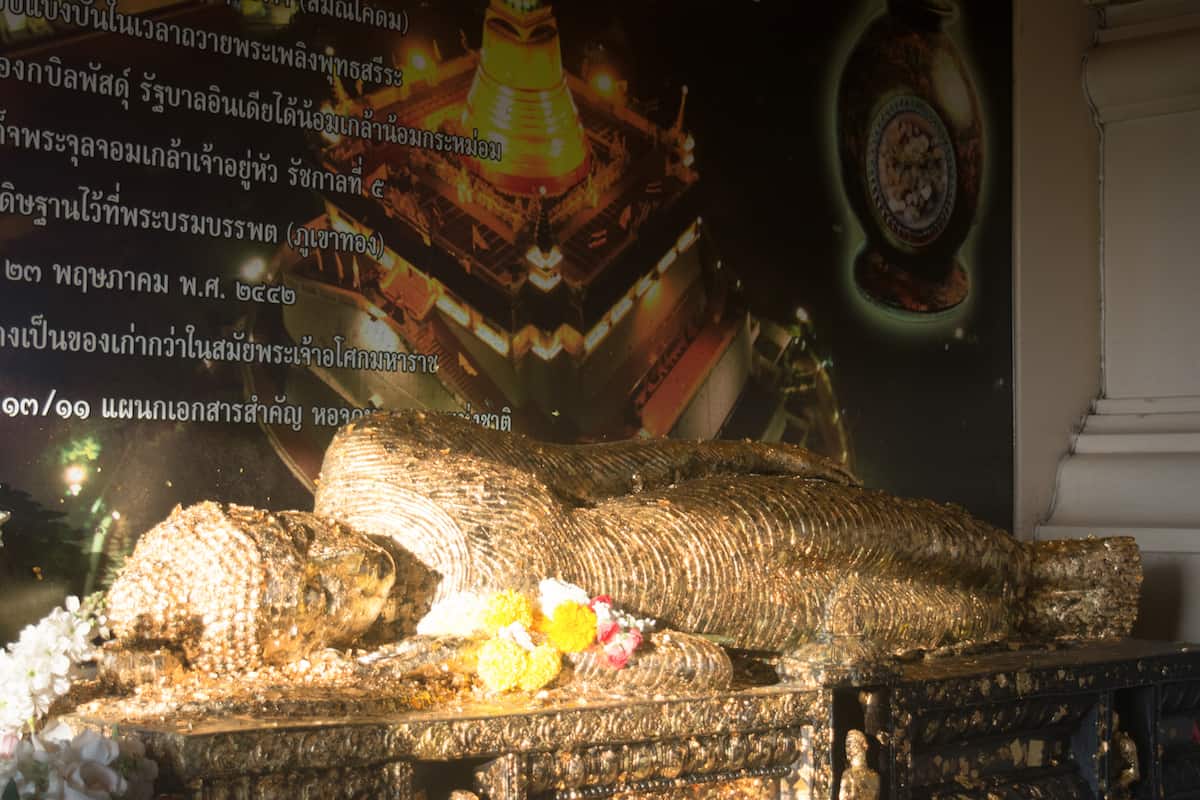
Wat Saket, Golden Mount, is a Buddhist temple which can be traced all the way back to the 14th century. It is located atop of an 80-meter (262 ft) tall man-made hill with a great view at the city. To get to it you have to climb 344 steps wrapping around the hill. It is one of highlights of what to do in Bangkok that you cannot miss.
The The Golden Mount is open daily from 9:00 am to 5:00 pm and tickets costs 50 baht (1.5 USD) per person. It is next to Loha Prasat, your next stop!
6. Wat Ratchanatdaram and Loha Prasat
The Wat Ratchanatdaram is a golden temple built in 1846, famed for being the world’s only brazen palace (a building of which its roof covered by bronze tiles). Wat Ratchanatdaram is best known for its 36-meter-tall amazing multi-tiered structure featuring 37 metal spires representing the 37 virtues toward enlightenment in Buddhism.
Wat Ratchanatdaram is open daily from 8AM to 5 PM and the entrance is free, although donations are always appreciate it.
Wat Ratchanatdaram and Loha Prasat are some of the best hidden gems in Bangkok, so make sure to add it to your 3 days in Bangkok itinerary. Loha Prasat it is right next to Wat Ratchanatdaram. We recommend going to the roof for an amazing panoramic view of Bangkok. To get up there, you must give a small donation.
7. Wat Benchamabophit
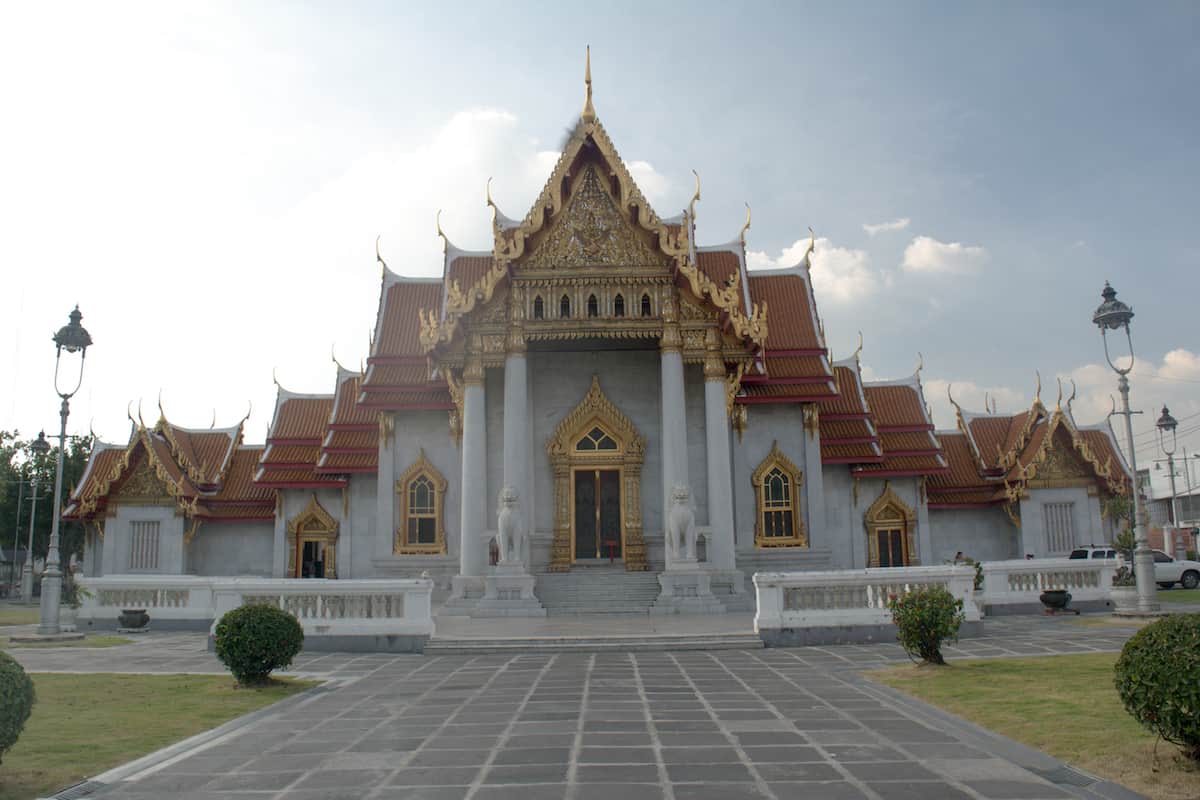
As an example of modern Thai architecture with a unique mix of Thai and European influences made of Italian Carrara marble. The Wat Benchamabophit, the marble temple, graces the back of the 5 Baht coin. In my opinion the most beautiful temple in Bangkok and because it is not as tourist yet, you can enjoy it pretty much by yourself. The temple is a must-see tourist sights of Bangkok and definitely and off the beaten path.
In the courtyard, there are 53 Buddha images representing every mudra (gesture) and style from Thai history. You can also take a stroll beside adjacent canals filled with blooming lotus and Chinese-style footbridges.
Wat Benchamabophit is open from 6:00 am to 6:00 pm. Tickets are 50฿ per person ($1.47 USD). The temple is only 5 minutes away by car from the Golden Mount.
➳ Tip: Sunrise is the best time to visit Wat Benchamabophit or at least early morning to avoid crowds.
8. Baiyoke Sky Tower Observation Deck

If you’re looking for a spectacular way to end your stay in Bangkok, consider watching the sunset from one of the city’s many rooftop bars. With a 360-degree view of the city from 48 stories up, it’s an unforgettable experience.
The Baiyoke Sky Hotel towers 84 stories above Bangkok with its not to be missed observation deck. It is currently the 2nd tallest building in Thailand, at 309 meters. The breathtaking viewing experience of Bangkok’s skyline from revolving rooftop observation deck on the 84th floor is complemented by a fruit buffet.
Tickets cost depending on the time of your visit. From 10AM to 5PM tickets are 350฿. From 5PM to 11PM tickets are 400฿.
Another option is the Octave rooftop, the bar offers a stunning view of the city, and Happy Hour runs from 5:00 to 7:00 PM or King Power Skywalk with its fully transparent glass deck 78 floors high above Bangkok or the Sky Bar which is next to an excellent restaurant. Another option can be Above Eleven with its delicious Japanese and Peruvian fusion style or Vanilla Sky, which has a 360° view over the Bangkok skyline, Vertigo, Moon Bar or Skybar Sirocco.
Any of these places is best to go during sunset!
Tip: Some rooftop bars have a dress code, so be sure to check this in advance.
Watching the sunset from a rooftop is another of the things to do in Bangkok in 3 days you cannot miss. As you can see you have so many options to end your second day in Bangkok!
DAY 3: Visit more temples and let’s go shopping!
9. Chatuchak Weekend JJ Market
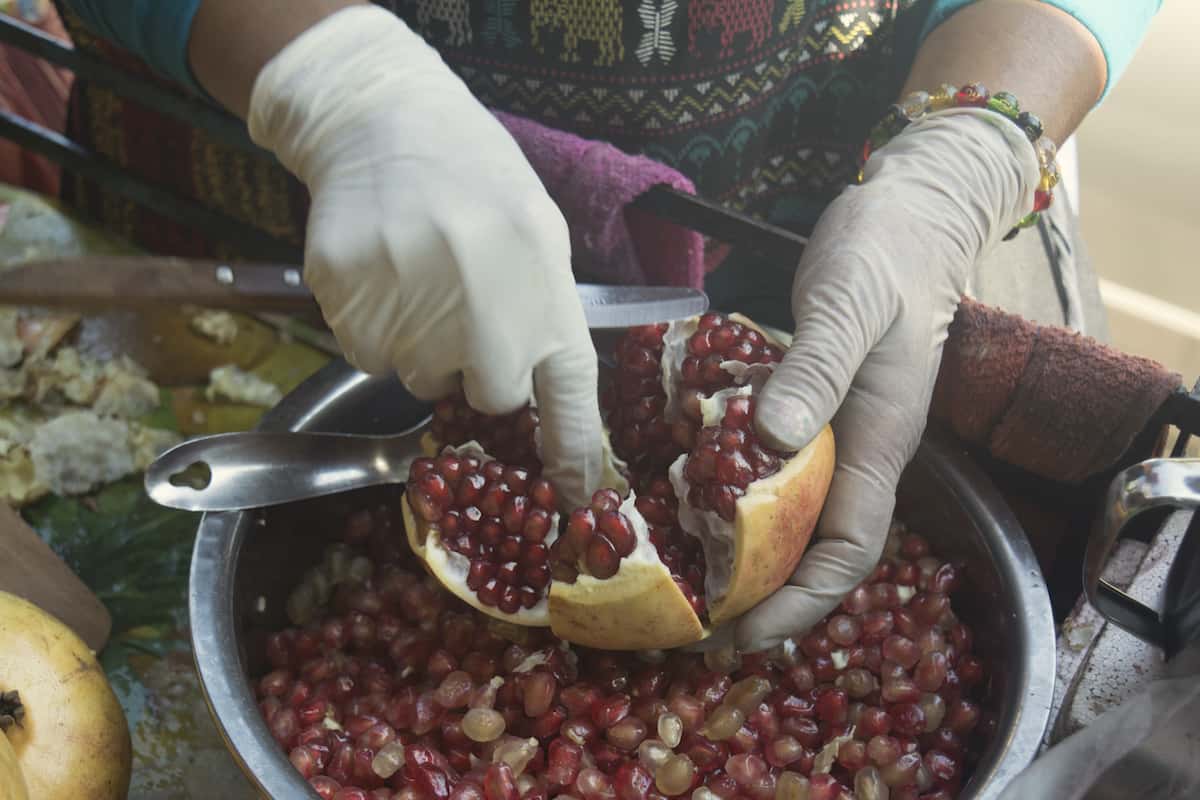
No Bangkok itinerary would be complete without visiting the famous and enormous Chatuchak weekend JJ Market! If it happens that your 3 days in Bangkok itinerary falls on a Friday, Saturday, or Sunday make sure to add this to your list of things to do in Bangkok in 3 days!
If you are into shopping then you must visit Chatuchak Weekend JJ Market. It is the largest outdoor market in Thailand and one of the best things to do in Bangkok for sure. Taking up an area of 35 acres with more than 8000 market stalls divided into 27 sections. Chatuchak Weekend Market is the largest market in Thailand, taking up an area of 35 acres with more than 8000 market stalls divided into 27 sections. On one average weekend, around 200 000 people come to wander through a rich variety of goods such as clothes, antiques, plants, art, furniture and more.
Here you will find pretty much anything, you name it and probably they have it! Anything from cloth, soaps, artificial flower, paintings, purses, ceramic and there are several restaurants and food stands. The market is organized in different section based on the type of product such as used clothes, handcrafts, textiles, accessories, jewelry, plants, books, home decoration, furniture, pet accessories and much more. If you can think of, probably it is there!
The market is open from 6:00 pm until midnight on Friday and between 9:00 am to 6:00 pm on Saturday and Sunday. The plant sections are also open on Wednesdays and Thursdays, from 7:00 am to 6:00 pm.
It gets very hot so we recommend wearing sunscreen and bringing a hat, that is why I added as a first thing to do in the morning to avoid the sun later on. Without a doubt it is a must-do in Bangkok!
In case you are in Bangkok during the week and not during the weekend you can go to the Talad Rot Fai Night Market. It is open daily from 6:00 pm to 12:00 am and it is near the Thailand Cultural Centre MRT station. Make sure to add the right one, as there are two markets with the same name.
The best time to go is in the morning before it gets too hot. Make sure to bring enough water, wear comfortable walking shoes and enough cash, while remaining wary of the pickpockets.
Some of the food you must try in Bangkok are their different dishes with curries, Pad Thai, mango salad, chicken cashew and a fruit smoothie.
10. Wat Yannawa
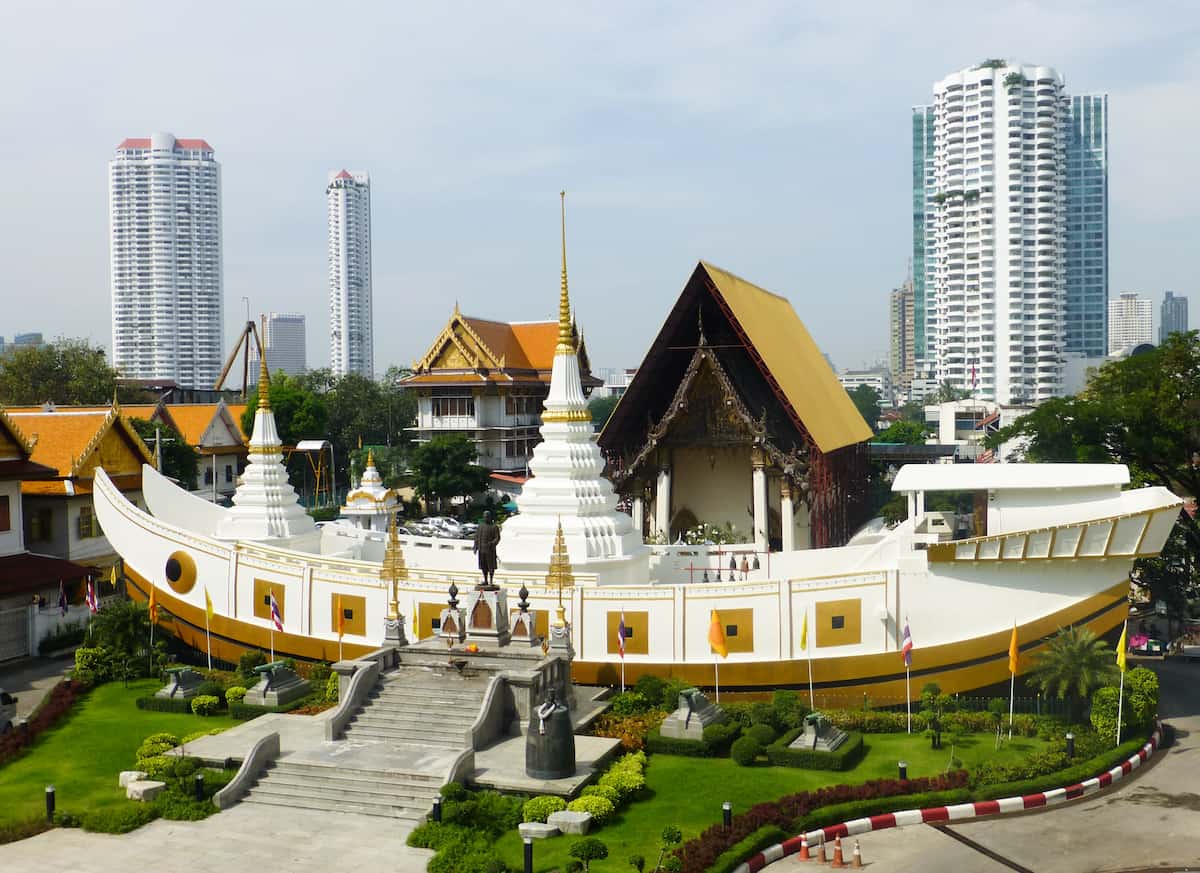
On the banks of the Chao Phraya river in Sathorn district is the Wat Yannawa temple, also known as “the boat temple” since it is built in a shape of Chinese junk vessel, a 19th-century sailing ship. As one of the older temples in Bangkok, it was built in memory of trade with China that brought prosperity to the Kingdom when this kind of vessels were used extensively. Make sure to add this temple on your Bangkok itinerary.
The temple is open daily from 8AM to 6PM.
11. Wat Traimit Withayaram Worawihan
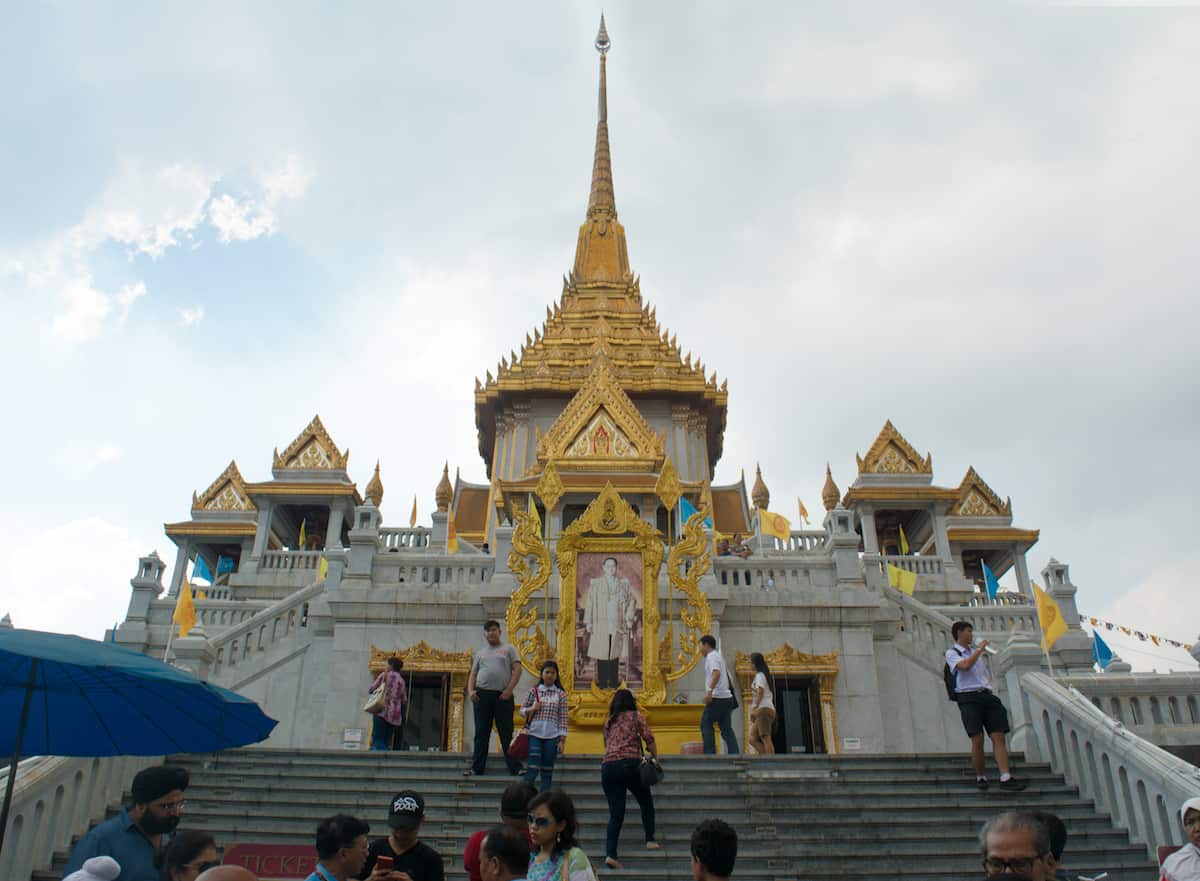
The Golden Buddha temple is located in Chinatown, high atop of a four-story marble-clad ziggurat, Wat Traimit is a home to the world’s largest massive gold seated Buddha, this huge temple has a massive 5.5 tons golden Buddha statue. The statue was cast sometime in the 13th century and is nearly five meters high and five and a half tons made of about 83% pure gold. The second floor of the ziggurat exhibits the history of the Chinese community in Bangkok, and the third floor covers the history of the Golden Buddha image itself.
Entrance to see only the Golden Buddha is 40฿. The museum costs an additional 100฿. The temple is open daily 8AM to 5PM, with the museum being closed on Mondays.
Tickets cost 40฿ each. There is also a museum under the statue that you can visit with a combined 100฿ ticket. You are not allowed inside with shorts or tank tops, so dress appropriately.
Outside the temple complex is the Chinese Gate, the symbolic entrance to the Chinatown which lays behind it. While you are in the Chinese town make sure to try some street food as it is considered some of the most delicious one.
We recommend going back at night to walk down Yaowarat Road. The road is full with neon signs making it so magical. During the day get lost in the alleyways, and find some old temples and shrines and exotic markets.
➳ Tip: Make sure to visit Wat Traimit Temple and Sampeng Lane.
12. Khao San Road and Soi Rambuttri
If you’re a budget backpacker visiting Bangkok, Khao San Road and Soi Rambuttri should definitely be on your list of places to check out. Khao San Road is a vibrant street filled with small bars, food stalls, souvenirs, and cheap buckets of alcohol, as well as sellers offering fried scorpions for the daring. It’s a bustling hub of activity, and just walking through it is an experience in itself.
Next door to Khao San is Soi Rambuttri, which is a bit more laid back and relaxed. It has plenty of food stalls and restaurants where you can enjoy a meal or a drink while taking in the sights and sounds of the street.
It’s worth noting that if you’re planning on getting a ride to or from these streets, you should avoid taking a taxi or tuk-tuk as they are likely to charge you more than the going rate. Instead, order a Grab to ensure you get a fair price.
Thai Massage
You cannot leave Thailand without getting a relaxing Thai massage. They are pretty cheap starting from $9 USD an hour. You will find so many stores everywhere, literally every corner has at least two saloons. Even the airport has one! If you like to get a massage on your room, you can ask the front desk for more information. Some hoteles do offer that service, and it tends to cost about $3USD more.
If you have extra time:
Damnoen Saduak and Bangkok Floating Markets
Because the markets are located outside of Bangkok about one hour and a half it is best if you take an organized tour. There are tours that take you to the Damnoen Saduak Floating Market and the Maeklong Railway Market.
Damnoen Saduak floating market is one of the oldest floating markets, but there are other such as the Taling Chan Market, Bang Ku Wiang Market and Tha Kha. Keep in mind that vendors are charging tourists more than what things are worth, that is why bargaining is common. Sometimes you can get 20% to 40% of the original price. Thonburi is super picturesque, less touristy, and highly recommended to get a long-tail boat tour through its canals.
The Maeklong Railway Market is only a 25 minute drive from the Damnoen Saduak Floating Market so make sure to visit both! This is one of the most unique markets in the world as it sit atop of a train track and the train actually passes through the market several times a day.
Bangkok has a big network of canals that connects Bangkok throughout the whole city. One of the things you must do in Bangkok is taking a long-tail boat to explore the other side of Bangkok.
Wat Samphran (Dragon Temple)
An hour away from Bangkok you will find one of the most unique temples in Thailand, the Dragon Temple (Wat Samphran). The easiest way to get there is by taxi, we did so and it cost us $20 USD ($350฿-$400฿ each way) round trip.
The temple is a 17-storey tower (80 m) with a dragon around it. To get to the top of the tower you must go up through the inside of the dragon’s body. Unfortunately, the temple has gone unreapiar and the elevator doesn’t work. Tight now they are trying to raise money to fix the elevator.
Once you get to the top of the tower, you will find a worshipping site where you can ask the dragon for a wish.
Officially registered in 1985, the Buddhist temple’s architecture fuses Chinese-Thai design. The temple grounds are built in the traditional Thai-Buddhist style, with a great emphasis on gold and spires. While dragons play a pivotal role in both cultures’ lore, the dragon at Wat Samphran is built in accordance with Chinese depictions of the creature.
Ancient Siam
Ancient Siam also know as Samut Prakan Ancient City or Muang Boran Museum is the biggest open air museum in the world. It is quite far from Bangkok (about an hour away). The museum has the shape of Thailand map and has over 200 acres of land with more than 100 recreations of Thailand’s landmarks that are replicas of temples, palaces, pavilions, floating markets, and Buddha images. The interesting part is that the monuments are placed at the correct geographical location.
We actually made it there but could not stay. We thought it was a temple not an amusement park so we hired a taxi and he was charging us per hour so we had to literally by an ice cream and turn around. It was so sad, but hey it means we have to come back!
The tickers are 700 baht (22 USD) per person and it includes a free rental bicycle at the entrance to make it easier for you to go through the park! If you do not like paddling then you can rent a golf cart (350 THB first hour, 200 THB each extra hour) or wait for the organized free shuttle buses to take you around, although it only has 4 stops for 20 minutes each every hour and a half.
Ancient Siam is open from 9:00 am to 7:00 pm. The best way to go is by taking the BTS SkyTrain to the Kheha Station, then change to a local Songtaew (30/36) or take a taxi for about 10 minutes to reach the museum.
I am sure you have seen some of these temples before (Temple Surrounded by Lizard Dragon-Sumeru Mountain), especially a drone shot. Unfortunately, drones are not longer allowed at the park!
Places within the park you must visit:
- Temple Surrounded by Lizard Dragon (Sumeru Mountain)
- Pavilion of the Enlightened
- Sanphet Prasat Throne Hall, Ayutthaya
- The Phra Kaew Pavillion
Wat Makutkasattriyaram
King Rama IV wished to have two temples built along the banks of Phadung Krung Kasem canal. One for himself, Wat Makutkasattriyaram, and one for his queen, Wat Somanasvihara. The temples are interesting for the murals depicting scenes from about the Buddha’s disciples, an illustration of meditation techniques, commandments to observe and more!
Wat Intharawihan
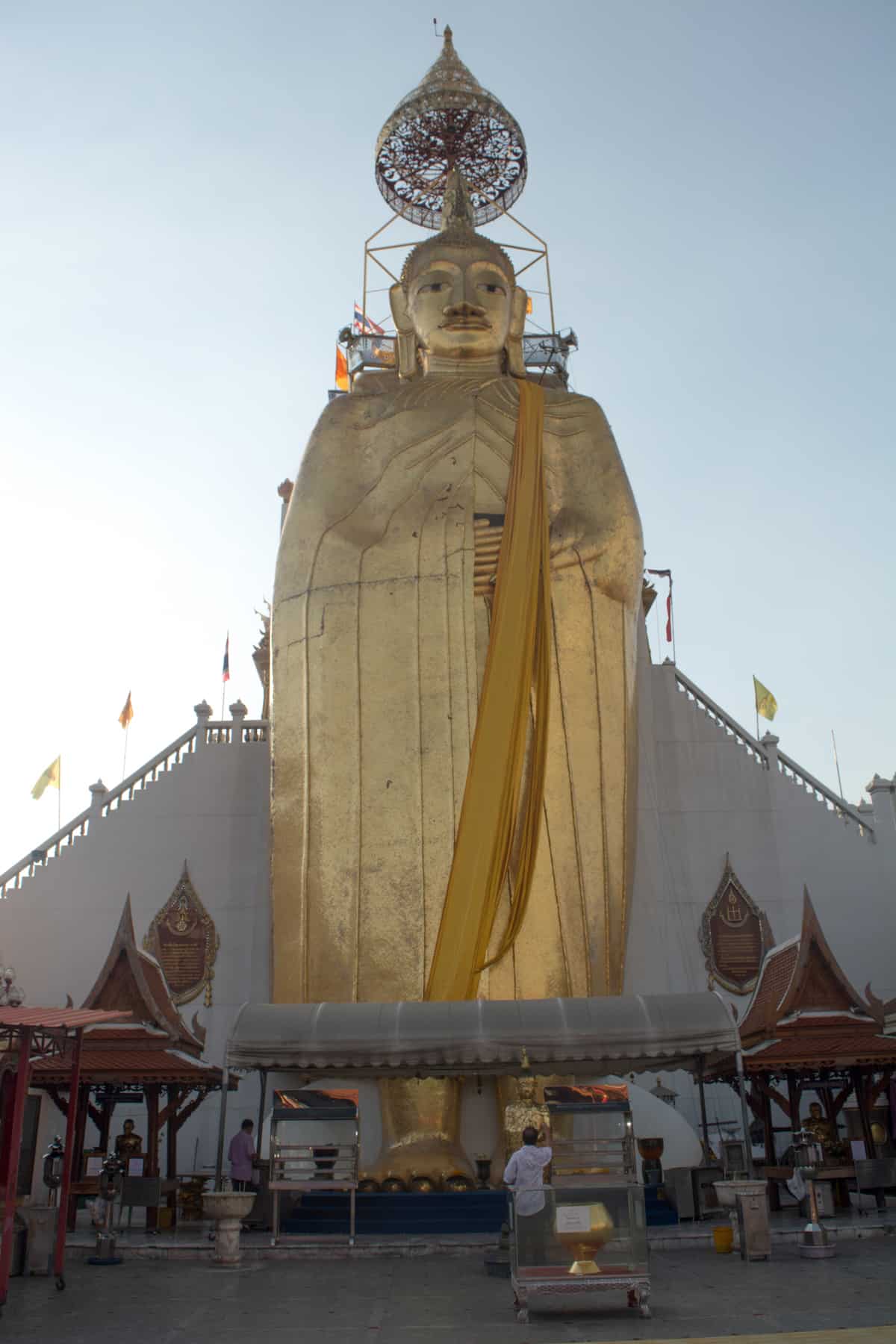
Wat Intharawihan temple is known for a giant, 32 Meter tall and 10 meters wide standing Buddha image holding an alms bowl. A bowl that monks even today use to receive food from people. The founding of temple itself preceded the founding of Bangkok in 1782, while the Construction of the Buddha image started in 1867 and was finished 60 years later, in 1927.
Wat Intharawihan is free to enter and open daily from 8:30AM to 8PM.
Democracy Monument
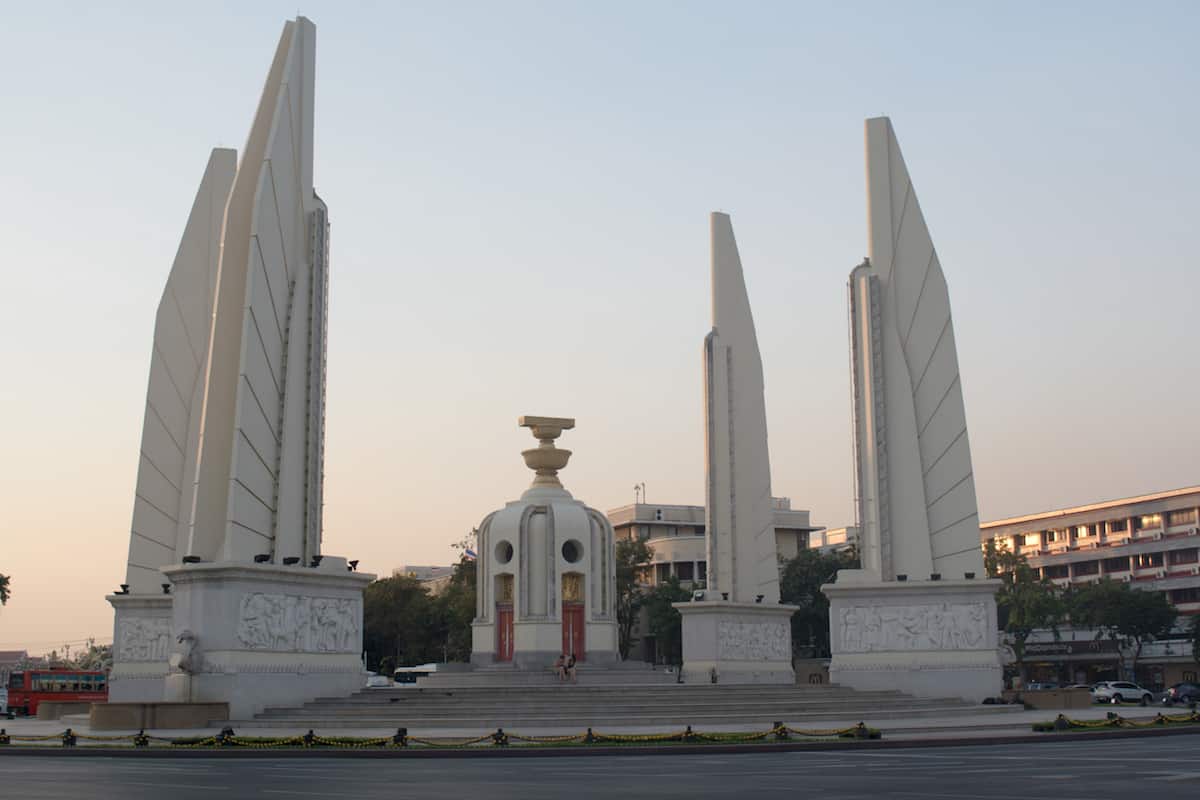
The Democracy Monument is situated in the center of Bangkok, commemorating the 1932 revolution that ended the absolute monarchy and introduced Siam’s first constitution. The four wings are each 24 meters high as a symbolic reference to the 24th of June, the date the new constitution was signed. Since the traffic around the monument can be a bit daunting there are underground passages that bring you to the monument itself.
Giant Swing at Wat Suthat

Although boasting an impressive interior architecture, the cloistered courtyard featuring 156 Buddha images along the outer walls, the main chapel’s wall frescoes inside detailing the previous 24 incarnations of the Buddha, Wat Suthat Temple is still most famous for its Giant Swing.
Standing at 21.15 meters, the Giant Swing was used during the Brahmin ‘thanksgiving’ ceremony with the custom for a young man to ride the swing high in the air and once in full swing to try to grab a bag of silver coins with their teeth. This ceremony was discontinued in 1932.
Wat Suthat is open daily from 8:30AM to 9PM.
National Museum
Often lauded as the Southeast Asia’s biggest museum, the National Museum houses the largest collection of Thai art and artifacts in the country. The exhibits are divided into three areas depending on the area of Thai history they are referring to.
Perhaps the most exciting part of disclosed exhibits are the decorative arts and handicrafts, but worth mention also the Gallery of Thai History featuring country’s most beautiful Buddha images as well as Bhuddhaisawan (Phutthaisawan) Chapel with well-kept murals and most revered Buddha image, Phra Phuttha Sihing.
The National Museum is open Wednesday through Sunday from 9AM to 4PM. Tickets are 200฿ per person. Take advantage of their free guided tour twice a week (Wednesdays & Thursdays at 09:30 am).
Dusit Palace Park
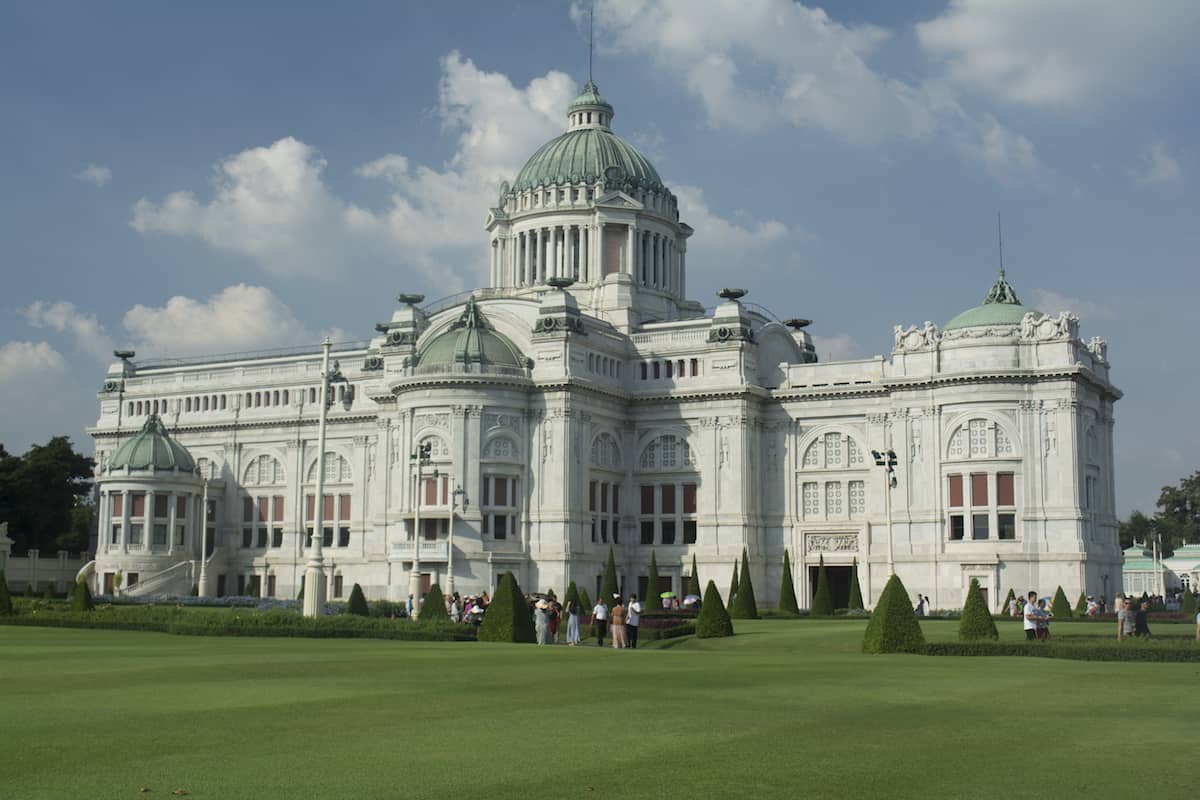
Dusit Palace Park once was a home to royals, created having in mind the European castles but by following a unique Thai expression. Today, the complex is a home to a museum and other valuable cultural collections.
Its Vimanmek Teak Mansion comprises of 81 rooms said to be world’s largest golden-teak building, apparently built without the use of single nail! Make sure to visit adjacent Ancient Cloth Museum featuring the finest royal robes made of traditional silks and cotton as well as Royal Thai Elephant Museum to learn about the significance of elephants in Thai history.
Dusit Palace Park is open Tuesday through Sunday from 9:30AM to 4PM. Tickets are 100฿ per person.
Vimanmek Mansion
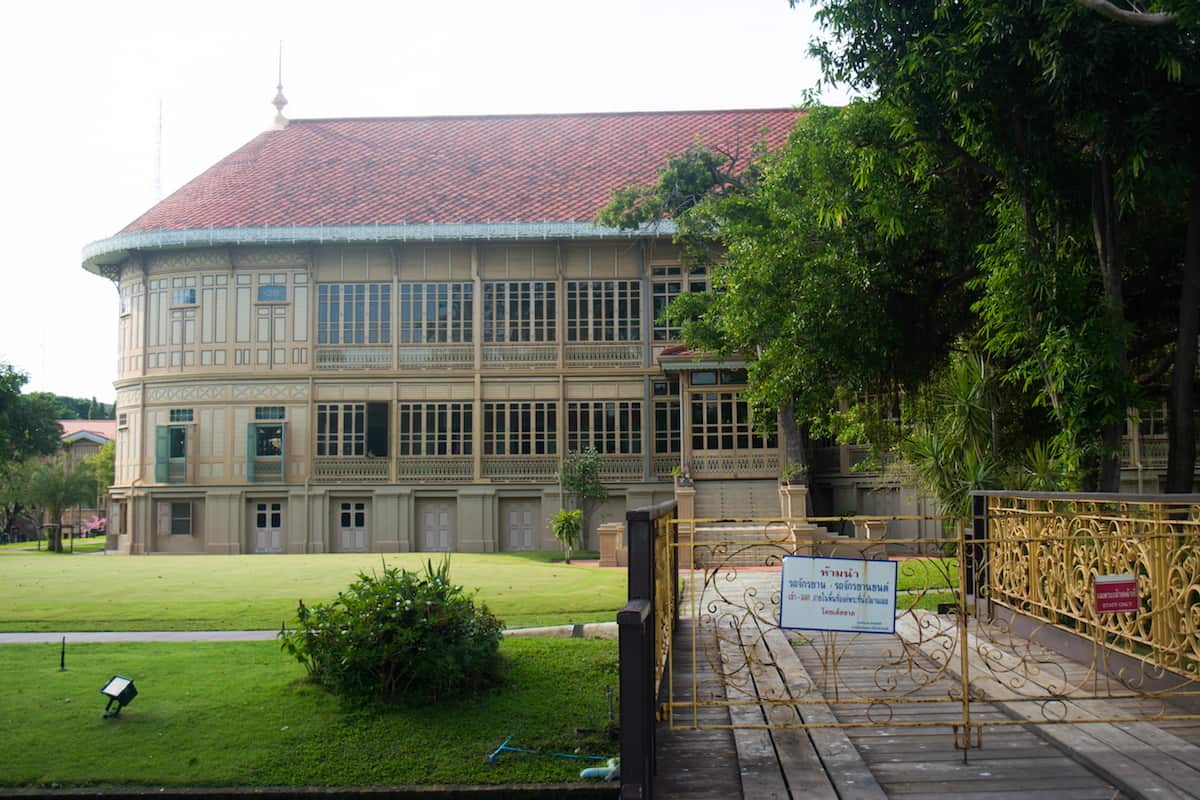
Built as a royal residence in the first few years of the twentieth century, Vimanmek Mansion is impressive and supposedly world’s largest teakwood building, home to a museum honoring Thai history.
There are a few rules to obey and take note of before a visit. Women are required to wear skirts or pants extending at least to the knee, and also should cover shoulders and men are advised to wear long pants and long sleeved shirts. Thi
The Vimanmek Mansion is open from 8:30AM to 4:30PM. Tickets cost 100฿ per person.
National Assembly of Thailand
The Parliament House of Thailand is located in the Dusit district in the capital. With an entrance ticket to the building, you get a free photo with you from the outside of the building.
Tickets cost 150฿ + free photo from outside!
Government House
The center of state administration, The Government House, also known as ‘the palace of gold’, was heavily influenced by Venetian Gothic architecture and Thai design. When looking at this building, it is easy to understand why Bangkok is called the ‘Venice of the East’.
The only time members of the public are allowed into Government House is on National Children’s Day in Thailand, the second Saturday in January. On any other day, you can get a free photo of yourself and the building from the outside!
Victory Monument
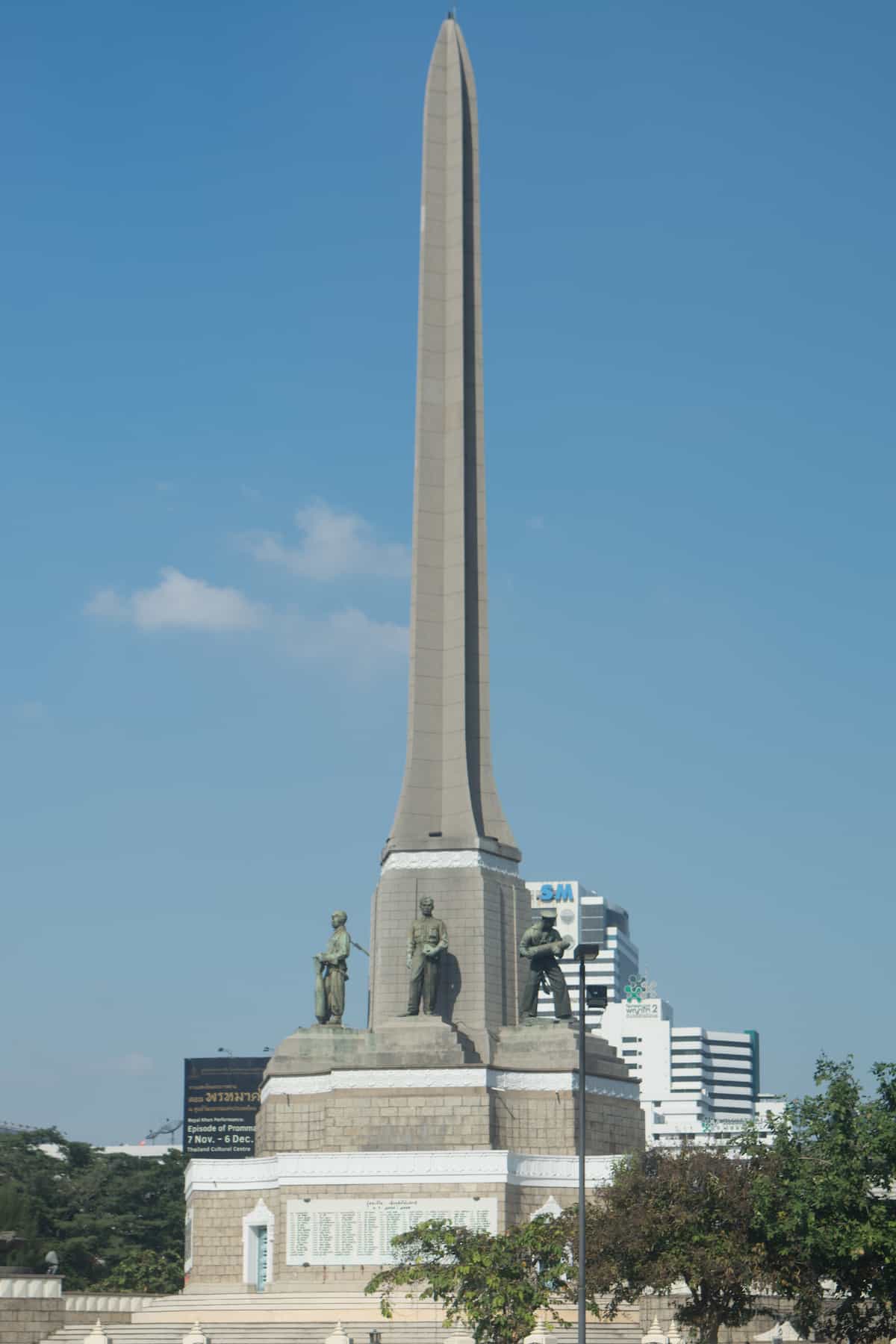
Victory Monument is a large military monument erected in 1941 in memory of what at the time was considered to be a Thai victory in the Franco-Thai War. Five statues around the base represent the army, navy, air force, police, and civilians. The monument today serves as one of the busiest transportation hubs in Bangkok from where you can catch buses or vans to the city’s outskirts and nearby beach towns.
Erawan Shrine (Small Buddha)
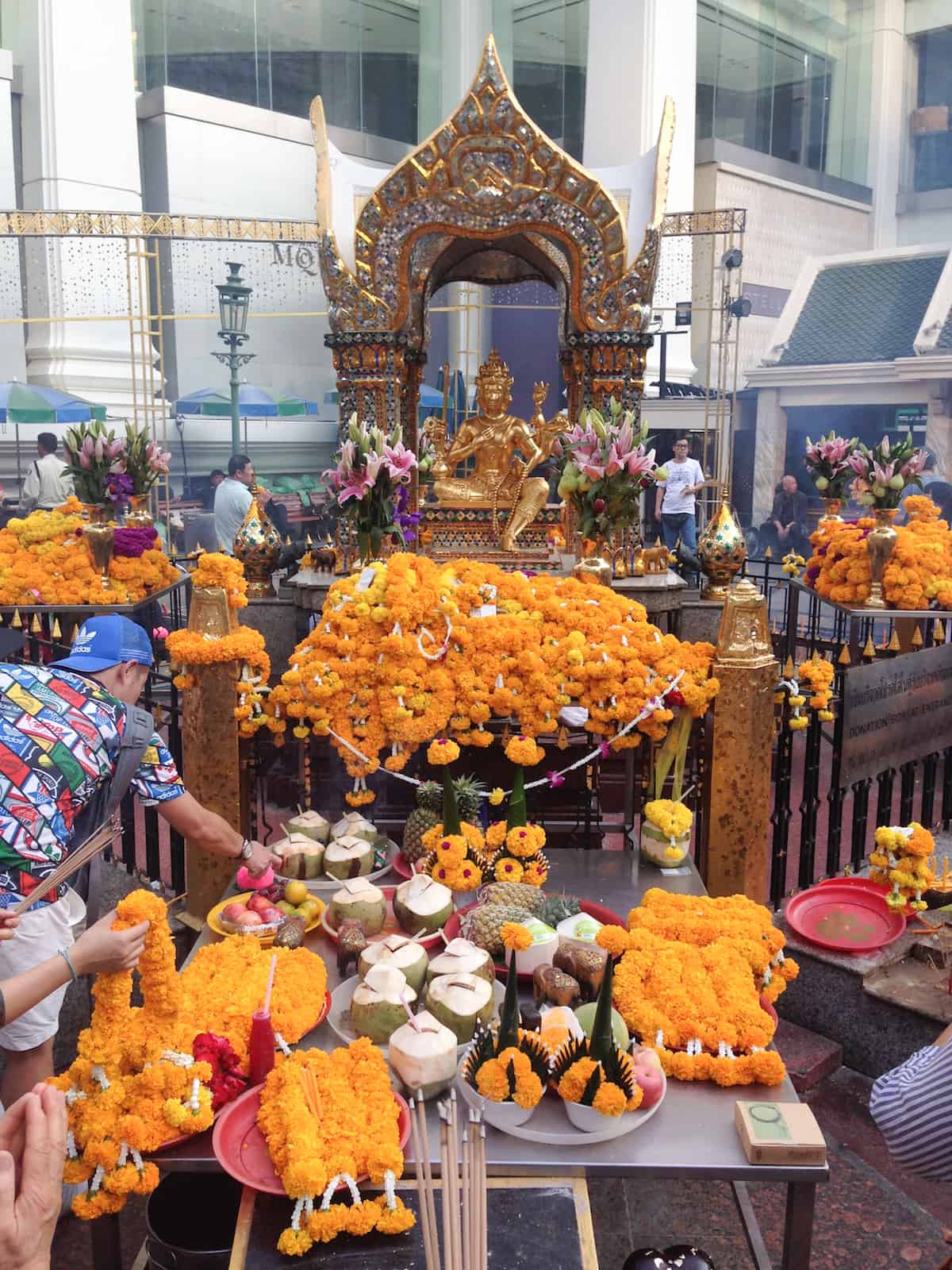
This famous shrine attracts more visitors than many of the city’s temples, it is often packed with tourists and worshippers alike as it is one of the holiest sites in Bangkok. Built in 1950s this shrine honors the four-faced Hindu God Brahma God, Phra Phanom, with each face representing one of the four virtues of kindness, mercy, sympathy and impartiality.
This beautiful little shrine In the evening there are often traditional Thai dance troupes that perform as a they are thanking the shrine for having their prayers answered, and are not to be missed.
An unending daily stream of visitors come to the shrine offering floral garlands, fruits and teak wood elephants hoping their wishes will come true. Additionally, witnessing a live performance of Thai Classical Dance troupe or a lively Chinese Lion Dance definitely adds to a list of reasons why one should not miss the Erawan Shrine.
Lumpini Park
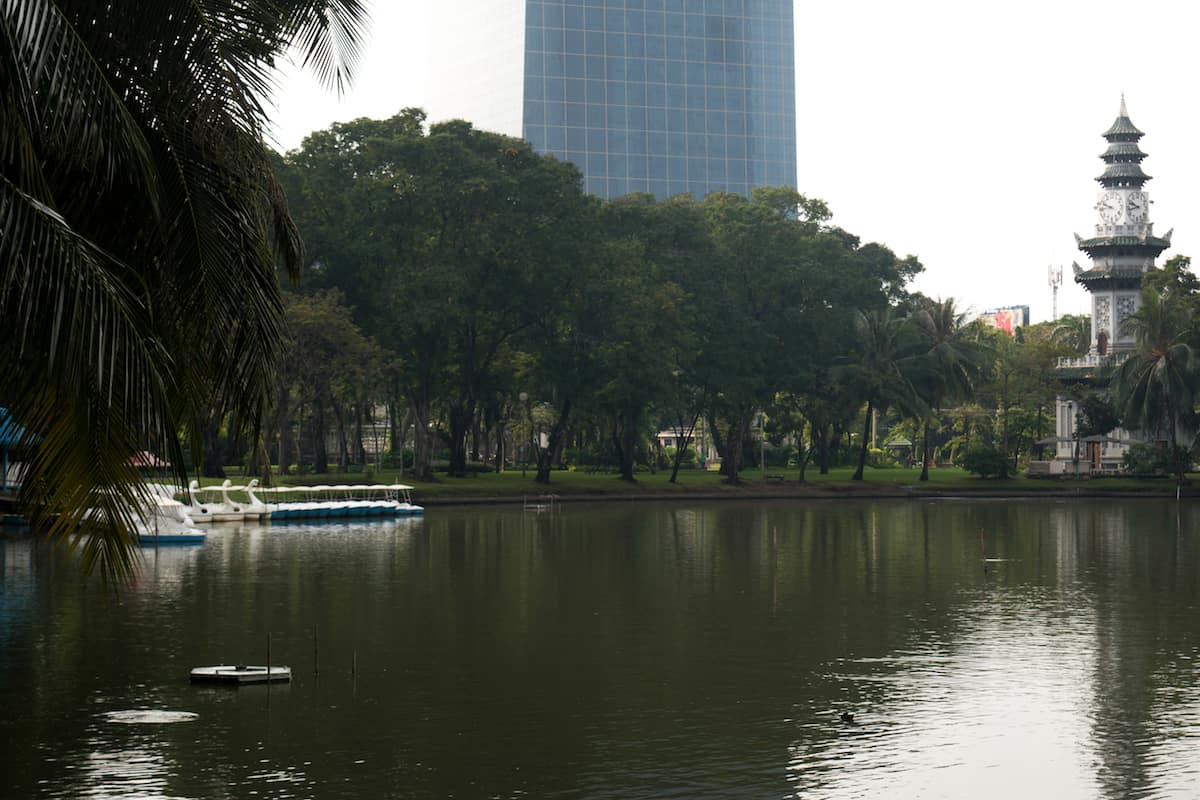
If you looking for a calm place in the city head to Lumphini Park! Try to make it before 7AM when the air is still relatively fresh and if you fancy, join groups of people practicing Thai or in the evening, join groups doing aerobics. You can also rent a paddle boat and paddle your way across the artificial pond overlooking the swept lawns.
Sri Maha Mariamman Temple
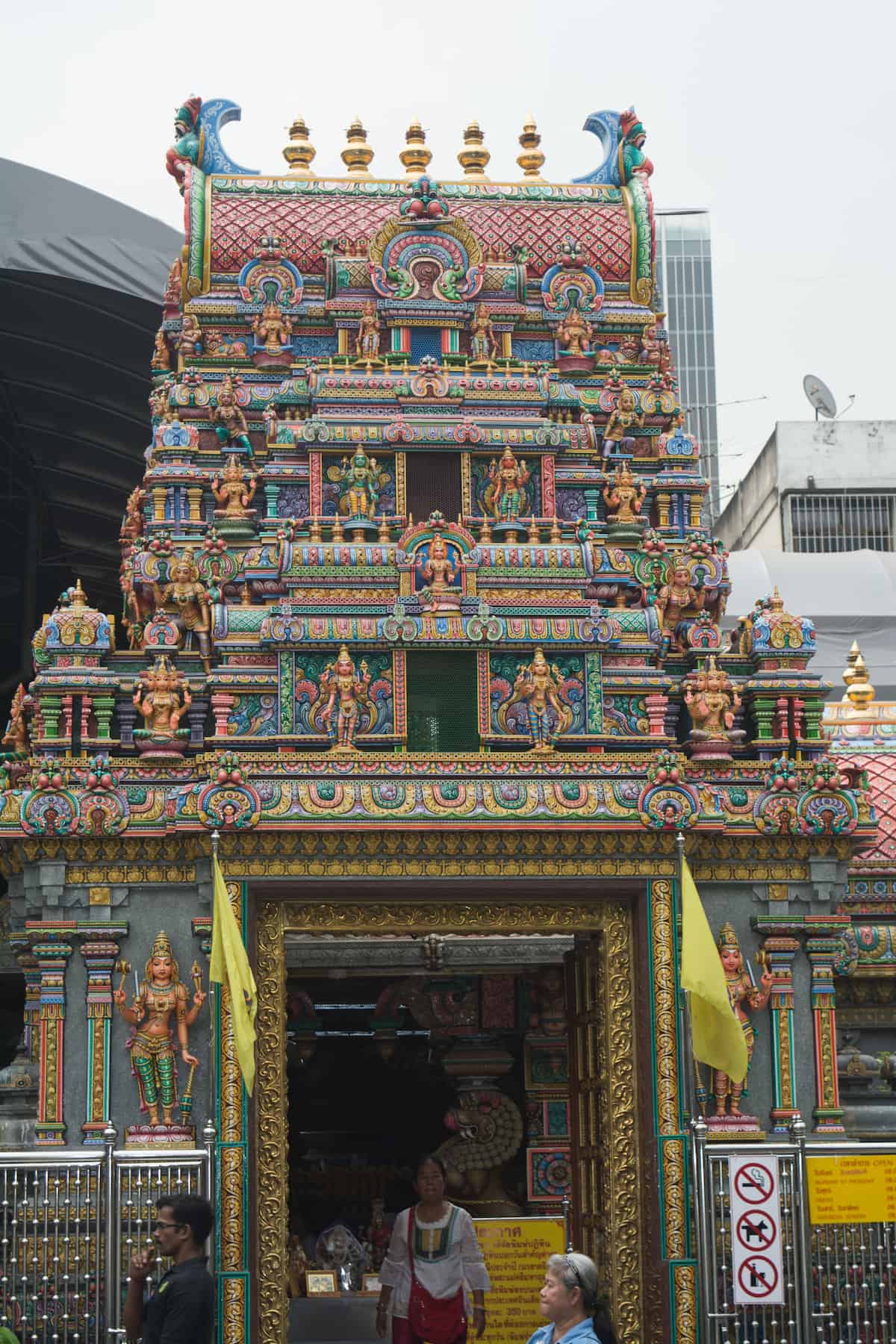
The beautifully ornate and flamboyant Sri Maha Mariamman Temple (also called Wat Prasri Maha Umathewee) is over 100 years old. It is a main Hindu temple built by a Tamil immigrant in honor of the goddess Mariamman, revered as ‘the mother of God’. The entrance to the temple is striking with a colorful tower (gopuram) depicting various Gods and Goddesses.
The temple is open daily from 6AM to 8PM.
Chinatown Gate

The Chinatown Gate is the entrance to the energetic 1-kilometer long strip known for cheap and delicious street food, gold shops, market stalls and Chinese temples. It is also one of Bangkok’s best areas for walking due to the lack of traffic and its narrow lanes. If you want to experience the Chinatown at its craziest and fullest hours then plan your visit during Chinese New Year.
Dusit Zoo
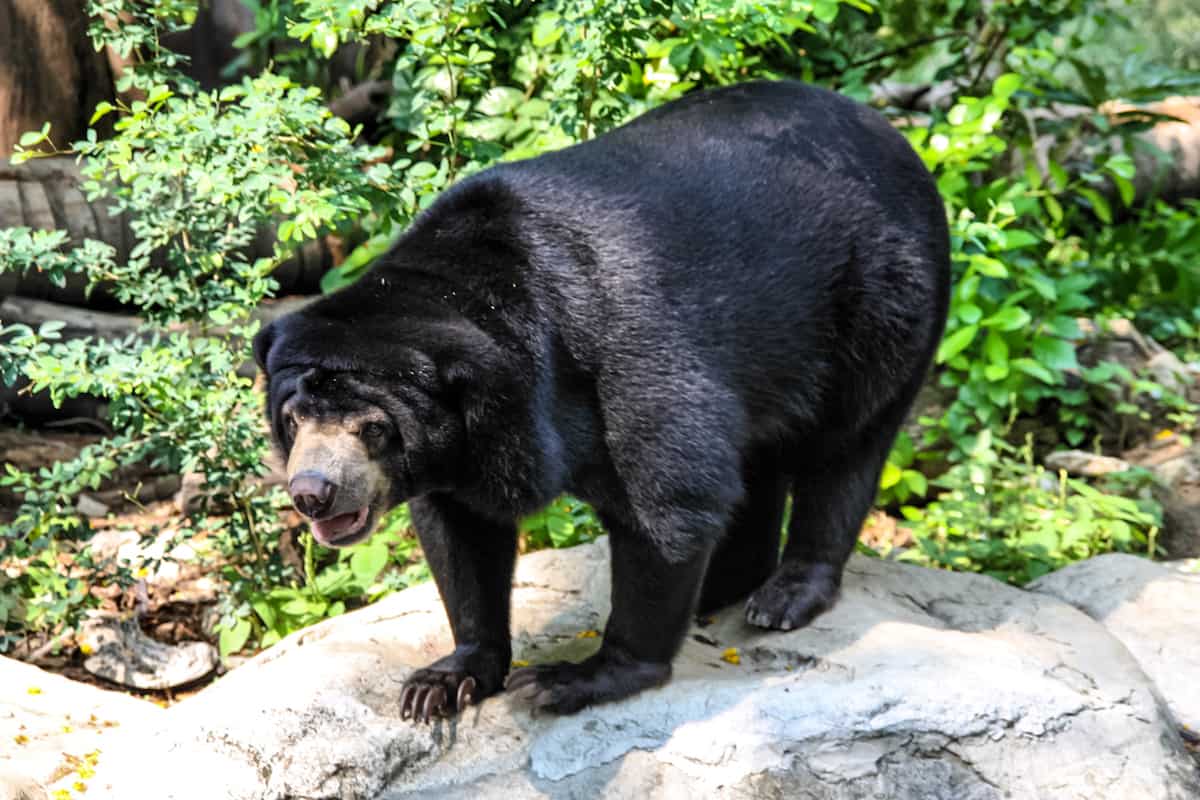
Dusit Zoo or ‘Khao Din’ is Thailand’s first animal zoo, over 60 years old. It it home to around 1600 domestic and international animals with accompanying facilities including an animal hospital, zoo museum, and educational center and sightseeing train.
For a small fee, you can enjoy the boat peddling at the zoo’s impressive lake while feeding the fish. If you are tight with time but you would like to see as much as possible, then we recommend to catch the tram and enjoy a 20-minute long ride around the zoo’s premises.
The Dusit Zoo is open daily from 8AM to 6PM. Ticket cost 150฿ per adult.
